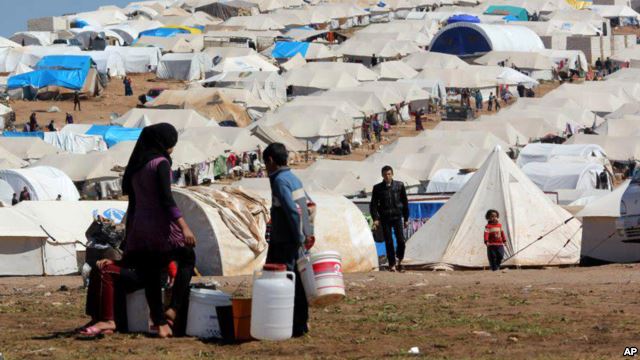

06/20/2014
On World Refugee Day (June 20), the ever helpful mainstream press presents the refugees as the issue du jour important for public awareness according to liberal values, but not important enough for explaining the causes. The New York Times headlined Refugees at Levels Not Seen Since World War II but did not place the story on Fridays front page.
Perhaps details are unkind to diversity ideology with its crazy idea that all cultures are equal.
Below, a Syrian refugee camp.

The Associated Press listed the countries on earth with the worst refugee problems. Funny, but most refugee-creating conflicts have been propelled by Islam and its belief that murder for Allah is the highest good. The top three Afghanistan, Somalia and Syria are all Muslim-on-Muslim wars, either tribal or religious.
Therefore the refugees caused by jihad should remain within the worldwide Muslim community (the ummah), not rescued by the West. Its only fair.
A look at countries generating the most refugees, Associated Press, June 20, 2014
The countries generating the most refugees are all conflict zones. The three biggest refugee populations are from Afghanistan, Somalia and Syria, which together account for more than half of all the worlds refugees, according to an annual report by the Geneva-based U.N. refugee agency. By descending order, the top 7 are:
AFGHANISTAN
Afghans have been fleeing the country in droves for decades, and their country is still the single biggest source of refugees although Syria has emerged as a strong second. As of the end of 2013, 2.56 million Afghan refugees were living in 86 countries, meaning one of every five refugees in the world is from Afghanistan. Most are in Pakistan or Iran, followed by Germany.SYRIA
A heavy flow of Syrians fleeing the civil war, now in its fourth year, was behind a huge increase in the overall number of refugees last year. The fighting forced 2.47 million people to flee the country and left 6.5 million others internally displaced by the end of 2013. Only two years before that, Syria ranked 36th in the U.N.s annual Global Trends Report on source countries for refugees. Most of the refugees have gone to neighboring countries, especially Lebanon, which has been strained by the influx. Syrias exodus last year was the single-biggest since the 1994 Rwanda genocide, when 2.3 million fled their homes.SOMALIA
The number of 1.12 million refugees from the lawlessness in Somalia is little changed from a year earlier. The pace of the exodus into Kenya and Ethiopia slowed a bit in the past two years amid hopes for improved security, but 9,700 Somalis still risked journeys across the Gulf of Aden or the Red Sea to reach Yemen.SUDAN
In 2013, the number of Sudanese refugees rose to 649,300, an increase of 80,000 from the year before. Chad and South Sudan were the biggest recipients. Since conflict broke out in 2011, some 294,000 Sudanese have fled the country.DEMOCRATIC REPUBLIC OF CONGO
At least 55,000 people originating from the Democratic Republic of the Congo were forced to seek refuge in neighboring countries. Still, the overall number of DRC refugees dropped from 509,500 at the start of 2013 to 499,500 a year later. The main reason was the return of almost 63,000 DRC refugees from the Republic of Congo. Another reason the number dropped resulted from the verification of registration records in Uganda and other countries in the region.MYANMAR
The Asian nation has generated the sixth-most refugees in the world, some 479,600 by the end of 2013. Much of this is from the statistical inclusion of 57,500 unregistered people from Myanmar in the refugee camps in Thailand, a change from the past.IRAQ
There were 401,400 Iraqi refugees in 2013, far less than the 745,900 reported a year earlier. Many had fled into Syria and Jordan, but with the war raging next door the number of Iraqi refugees reported in Syria dropped from 471,400 down to 146,200. Many other Iraqis fled to Iran and Germany.